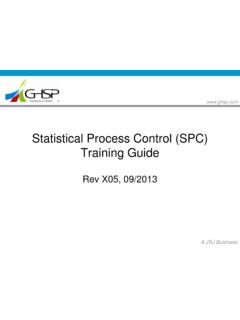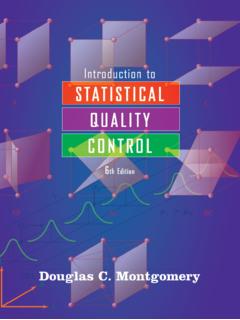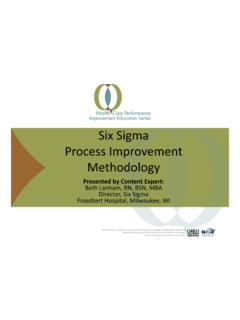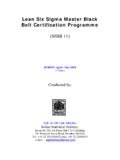Transcription of Statistical Techniques for Forensic Accounting ...
1 Praise for Statistical Techniques for Forensic Accounting Financial statement fraud has never been a more serious threat to the integrity of our capital markets than it is today. Professor Dutta discusses the auditing and Statistical tools available to detect and investigate financial fraud, set against a colorful backdrop of fraudsters, whistleblowers, and corporate scams that proves fact is stranger than fiction.. Dennis Caplan, University at Albany, New York Quantified evidence is often most persuasive and is often required to propose adjust- ments or prove damages. All parties (management, auditors, regulators, litigants) are best served by applying defensible, well-thought-out Techniques when estimating propor- tions or amounts. Professor Dutta's book uniquely addresses a variety of Techniques that could be or are currently applied in supporting arguments and determining amounts.
2 A. number of these are illustrated with audit application examples.. Lynford Graham, CPA, PhD, CFE, Bentley University, Massachusetts Financial crime causes severe damages to capital markets. It not only affects investors who were deceived, but also reduces overall market return through dissipation of trust after fraud scandals. This causes a demand to detect and prevent financial crime in a timely manner. However, financial crime has been deliberately perpetrated by finan- cial or Accounting experts, which could not be detected by simple analytical Techniques . Advance Techniques such as sophisticated Statistical methods are more useful in detect- ing financial fraud schemes. This book will benefit researchers who conduct research using these Techniques to detect financial statement fraud. Other parties, such as audi- tors and regulators, could use them in developing financial statement fraud detection models.
3 Thawatchai Kiatkwankul, Security and Exchange Commission, Thailand I am very pleased to see this book by Prof. Saurav Dutta. It provides a rich discussion on Statistical concepts within the context of Forensic Accounting and fraud detection. It covers topics from why and how fraud is committed, to how one can detect it by using Statistical Techniques . He has used simple, familiar examples to illustrate the Statistical concepts applicable to Forensic Accounting and fraud. I wish him great success.. Rajendra P. Srivastava, Ernst and Young Professor, University of Kansas Professor Saurav has advanced the Accounting profession by providing students of Forensic Accounting with a resource that combines a superb overview of Accounting tools for fraud prevention with a careful introduction to the data-mining and Statistical tools needed for fraud detection.
4 Glenn Shafer, Dean, Rutgers Business School, Rutgers University, New Jersey In a passage cited by Professor Dutta, Holmes comments to Watson that: It is a capital mistake to theorize before one has data. Insensibly one begins to twist facts to suit theo- ries, instead of theories to suit facts.' Professor Dutta's treatise demonstrates not only the methods used to collect, assemble, and classify data, but, far more importantly, how to transform those data into evidence in short, how to develop theories to suit the facts available. The essential step in this analysis is, of course, inferential statistics. This path leading from data to evidence is expertly navigated by Professor Dutta in terms that will prove understandable and useful to accountants, auditors, and legal professionals engaged in Forensic Accounting .
5 Dave Marcinko, Skidmore College, New York Statistical Techniques . FOR Forensic . Accounting . This page intentionally left blank Statistical . Techniques . FOR Forensic . Accounting . understanding THE THEORY AND. APPLICATION OF DATA ANALYSIS. Saurav K. Dutta Vice President, Publisher: Tim Moore Associate Publisher and Director of Marketing: Amy Neidlinger Executive Editor: Jeanne Glasser Operations Specialist: Jodi Kemper Marketing Manager: Lisa Loftus Cover Designer: Alan Clements Managing Editor: Kristy Hart Project Editor: Elaine Wiley Copy Editor: Chrissy White Proofreader: Debbie Williams Indexer: Christine Karpeles Compositor: Nonie Ratcliff Manufacturing Buyer: Dan Uhrig 2013 by Saurav K. Dutta Publishing as FT Press Upper Saddle River, New Jersey 07458. This book is sold with the understanding that neither the author nor the publisher is engaged in rendering legal, Accounting , or other professional services or advice by publishing this book.
6 Each individual situation is unique. Thus, if legal or financial advice or other expert assistance is required in a specific situation, the services of a competent professional should be sought to ensure that the situation has been evaluated carefully and appropriately. The author and the publisher disclaim any liability, loss, or risk resulting directly or indirectly, from the use or application of any of the contents of this book. FT Press offers excellent discounts on this book when ordered in quantity for bulk purchases or special sales. For more information, please contact Corporate and Government Sales, 1-800-382-3419, For sales outside the , please contact International Sales at Company and product names mentioned herein are the trademarks or registered trademarks of their respective owners. All rights reserved.
7 No part of this book may be reproduced, in any form or by any means, without per- mission in writing from the publisher. Printed in the United States of America First Printing June 2013. ISBN-10: 0-13-313381-8. ISBN-13: 978-0-13-313381-3. Pearson Education LTD. Pearson Education Australia PTY, Limited. Pearson Education Singapore, Pte. Ltd. Pearson Education Asia, Ltd. Pearson Education Canada, Ltd. Pearson Educaci n de Mexico, de Pearson Education Japan Pearson Education Malaysia, Pte. Ltd. Library of Congress Cataloging-in-Publication Data is on file. To My Sons Saahil and Samir The Personification of my Aspirations This page intentionally left blank Table of Contents Foreword .. xiii Acknowledgments .. xv Preface .. xviii 1 Introduction: The Challenges in Forensic Accounting .. 1. Introduction.. 1. Characteristics and Types of Fraud.
8 3. Management Fraud Schemes.. 7. Employee Fraud Schemes.. 11. Cyber-crime .. 17. Chapter Summary .. 18. Endnotes.. 19. 2 Legislation, Regulation, and Guidance Impacting Forensic Accounting .. 21. Introduction.. 21. Legislative Response to Fraudulent Financial Reporting.. 22. The Emphasis on Prosecution of Fraud at the Department of Justice.. 24. The Role of the FBI in Detecting Corporate Fraud .. 26. Professional Guidance in SAS 99 .. 27. Chapter Summary .. 28. Endnotes.. 29. 3 Preventive Measures: Corporate Governance and Internal Controls .. 31. Introduction.. 31. Corporate Governance Issues in Developed Economies.. 33. Emerging Economies and Their Unique Corporate Governance Issues ..34. Organizational Controls.. 39. A System of Internal Controls .. 41. The COSO Framework on Internal Controls .. 46. Benefits, Costs, and Limitations of Internal Controls.
9 52. Incorporation of Fraud Risk in the Design of Internal Controls .. 56. Legislation on Internal Controls .. 58. Chapter Summary .. 58. Endnotes.. 60. 4 Detection of Fraud: Shared Responsibility .. 61. Introduction.. 61. Expectations Gap in the Accounting Profession.. 64. Responsibility of the External Auditor.. 66. Responsibility of the Board of Directors .. 68. Role of the Audit Committee.. 71. Management's Role and Responsibilities in the Financial Reporting Process .. 75. The Role of the Internal Auditor.. 78. Who Blows the Whistle .. 80. Chapter Summary .. 84. Endnotes.. 85. 5 Data Mining.. 89. Introduction.. 89. Data Classification .. 91. Association Analysis .. 93. Cluster Analysis.. 95. Outlier Analysis.. 98. Data Mining to Detect Money Laundering .. 100. Chapter Summary .. 103. Endnotes.. 103. 6 Transitioning to Evidence.
10 105. Introduction.. 105. Probability Concepts and Terminology .. 106. Schematic Representation of Evidence.. 108. Information and Evidence .. 110. Mathematical Definitions of Prior, Conditional, and Posterior Probability.. 110. x Statistical Techniques for Forensic Accounting The Probative Value of Evidence.. 114. Bayes' Rule .. 117. Chapter Summary .. 122. Endnote.. 123. 7 Discrete Probability Distributions .. 125. Introduction.. 125. Generic Definitions and Notations.. 126. The Binomial Distribution.. 127. Poisson Probability Distribution.. 135. Hypergeometric Distribution .. 140. Chapter Summary .. 145. Endnotes.. 147. 8 Continuous Probability Distributions .. 149. Introduction.. 149. Conceptual Development of Probability Framework.. 150. Uniform Probability Distribution .. 156. Normal Probability Distribution.
















